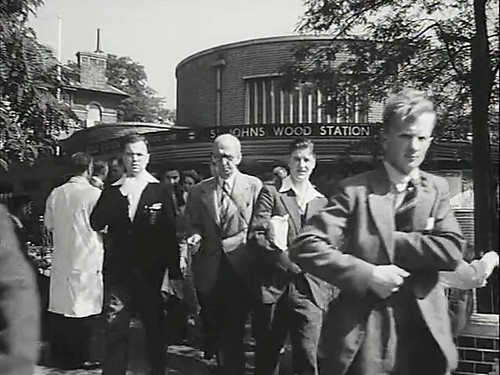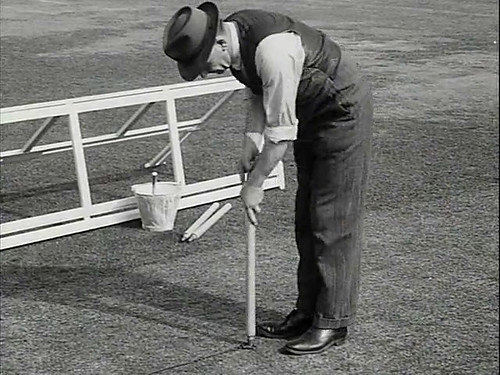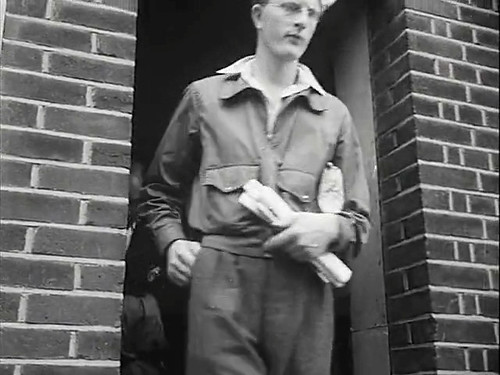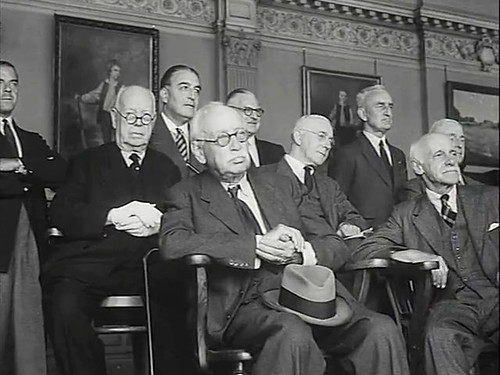The other day Russell linked to this 1950 film called Cricket. It’s all worth a watch but, because I’ve been thinking about suits recently, I was struck by the variety of suits on display.
Here are a few stills…
First, some spectators emerging from the tube on their way to Lord’s, showing two styles of dress. Two men with open collars, no tie, and the collars over the top of their suit lapels. It’s not a look you see much these days. The other two men are wearing ties and look a little less period.
I was struck that the chaps laying out the stumps were wearing pin-striped trousers (with wide gaps between the stripes), which was clearer in a close-up. I always think of pin-stripe as being a very formal, City-style suit. Without his jacket, you can see this man’s braces, and how highly-waisted the trousers are compared to modern day ones.
At the other end is this man, with a waistcoat and trilby (I think). He also has pin-striped trousers and his shirt has quite strong stripes (visible in a close-up). I’m not sure of the status of this man and the previous one. I assume they’re not particularly low-level workmen — in a following shot there are some guys doing more menial tasks, and they’re wearing overalls. I’m guessing that positioning the stumps etc. wasn’t something you’d leave to just anyone.
I like this shot. The first three men all have that open-necked, no tie, shirt collars over the top of suit lapels look. These days, when I see someone wearing a suit with no tie it looks either like they’re trying too hard to be casual (David Cameron) or like they’ve forgotten their tie (most tie-less suit wearers I see around the City). But wearing the shirt collar outside the suit makes this look a bit more purposeful. With a lighter-colour suit, it looks even more like an intentional relaxed look, rather than you’ve just left the office and taken your tie off.
Side note: The second and third guys in line here have two levels of pockets in their coats. Mmmm, more pockets are good.
Not a suit, but I quite liked this look. A blouson jacket, again with an open shirt collar over the top. Not sure about the pockets — it looks like they’re chest pockets which have sunk, but still, looks quite sporty otherwise.
Three chaps with trilbies and ties, a very short tie on the right there. Although nearly all the male spectators in the film are wearing suits, it’s still fairly easy to separate the classes, although subtleties are harder to distinguish, six decades on. These men are, I assume, a bit higher class than those up above with the open collars. Or they’re just more uptight. In the background is a man with a double-breasted suit, which I don’t think I saw any other examples of.
An older generation, which the narration suggests is in the Long Room. Three-piece suits, dark colours. Some great round glasses and, I think, a homburg on the front gentleman’s lap?
There is something faintly embarrassing about (a) writing about clothes when I know little about fashion (corrections and additions are very welcome!) and (b) writing about a period that’s recent enough for my parents to remember as if it’s ancient history. But still, I enjoyed looking at these.
Comments
Commenting is disabled on posts once they’re 30 days old.











antimega at 22 Feb 2011, 3:23pm. Permalink
I am fascinated in how quickly the dress of Britain changed. What happened? New fabrics? Change in work patterns? I'd guess there's a book on this, but I haven't found the answers yet.